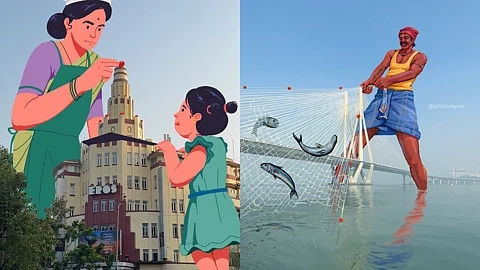
- HOMEGROWN WORLD
- #HGCREATORS
- #HGEXPLORE
- #HGVOICES
- #HGSHOP
- CAREERS
- ABOUT US
- CONTACT US

Life in a metropolis is a fast one. Here, in the everyday scramble it demands, it is easy to become desensitised to the forms that frame daily life — the familiar facades of old buildings, the towering new skyscrapers, the stitched-together skyline. But visual artist Omkar Patil has found a way to look at them again, in a new light. With a cycle, a sketchpad, and a disarming sense of curiosity, he has begun to reimagine the architectural landscape of Mumbai not as static structures, but as objects of everyday play and wonder.
Known for his commercial brand collaborations and mural work, Omkar has long kept a parallel thread of personal explorations running through his practice. His newest series of digital illustrations is one such thread where Mumbai's architecture is reimagined as something else entirely.
A dome becomes a coconut sold by a street vendor; a pointy skyscraper turns into a 2-tiered cake being decorated by a mother and daughter; the sea-link bridge morphs into a fishing net suspended in mid-cast. Each illustration offers a moment of levity, a shift in perspective that invites viewers to consider the urban environment not just as backdrop, but as a playground for imagination.
The idea began on two wheels. “I recently bought a cycle and started exploring the city on it,” Omkar shares. “Cycling gave me a completely different view of Mumbai. I started taking new roads, flyovers, and bridges, and began seeing the city from fresh angles.” It was on one of these rides that the Lodha towers, among Mumbai’s most recognisable luxury high-rises, caught his eye. From a certain angle, they resembled a stack of coins. That moment of visual association became the first in a growing series of illustrated interpretations.
Omkar’s process is both intuitive and deliberate throughout different stages. “Usually while travelling or cycling, if something catches my eye, it often comes with an instant idea,” he says. A photo is snapped, and an idea takes root. Once home, he sketches a few variations, always aiming to make the concept feel both playful and relatable. The final illustration is polished digitally, often blending elements of mixed media to suggest texture and tactility.
What makes these speculative works compelling is not just the cleverness of the visual metaphors, but the underlying tenderness with which they are rendered. In Omkar’s world, buildings are not inert. They carry the potential for nostalgia, and human connection. There’s an emotional architecture to his work too. His characters don’t float in hyper-tech fantasies; they stand on the soil, in worn-out slippers, beside banyan trees wrapped in solar panels.
“I’ve started paying closer attention to Mumbai’s architecture, and along with that, its history and stories,” he reflects. This is more than an art series. It’s a practice of noticing, of returning a sense of play to a city often experienced through the filters of urgency and routine. It’s also a personal archive, mapping not just the structures of Mumbai, but Omkar’s evolving relationship with them. He elaborates, "More than anything, it has made me more sensitive and aware of the city and the society I’m a part of, not just as an artist but as someone living and growing in it."
Follow Omkar here.
